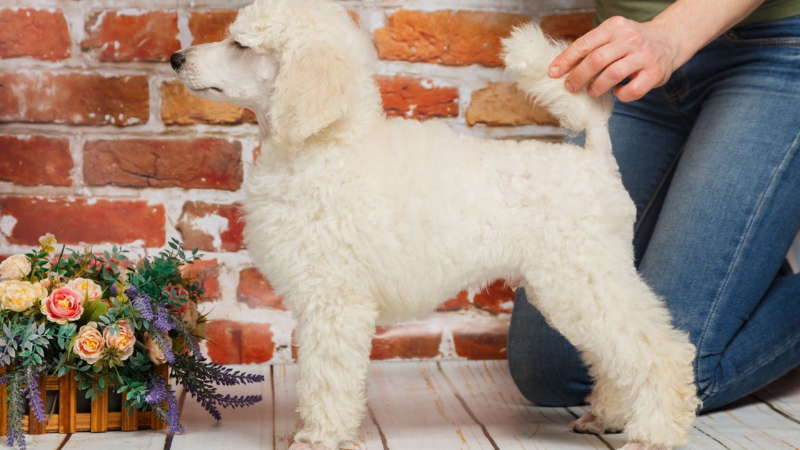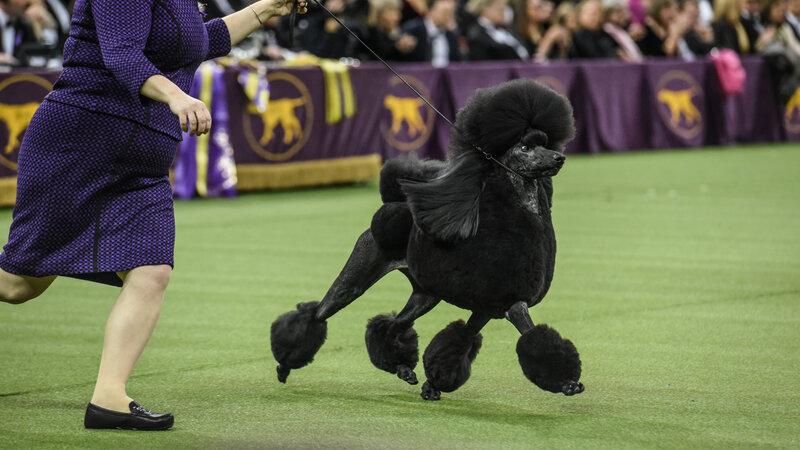Training a Poodle not only enhances its agility and health but also improves its behavior and obedience, among other benefits. Join Bach Hoa XANH as we explore this beloved breed and effective training methods.
1. What is a Poodle?
 Poodles are among the most popular dog breeds in Vietnam.
Poodles are among the most popular dog breeds in Vietnam.
Poodles, also known as skilled duck hunters and excellent swimmers, originate from Germany and France. Today, this breed is commonly crossbred to create adorable companion dogs with curly fur and a petite stature.
Poodles are renowned for their intelligence, agility, and obedience. Their German name, “Pudel,” translates to “diver” or “water dog,” reflecting their exceptional swimming abilities. In Vietnam, Poodles rank among the most favored dog breeds alongside the Pug and the Fox Terrier.
For further reading:
2. Training Methods for Poodles
Potty Training
 Potty training your Poodle
Potty training your Poodle
Teaching your Poodle to relieve itself in a designated area helps maintain a clean environment and significantly reduces the hassle of cleaning up after your pet. During this training process, it’s crucial to remain patient and persistent as accidents are bound to happen.
Here are the steps to potty train your Poodle:
Step 1: Assign a fixed spot for your Poodle to relieve itself.
Step 2: If your Poodle starts circling or lifting a paw, quickly carry it to the designated potty area.
Step 3: Wait patiently until your Poodle finishes its business. If it doesn’t go, make it sit there until it does.
Repeat these steps daily for about 10-15 days without giving up midway.
For more insights:
Teaching Your Poodle to Sit
 Teaching your Poodle to sit
Teaching your Poodle to sit
Step 1: When your Poodle is standing, place its favorite treat under its paws.
Step 2: Clearly and firmly give the command: “Sit,” while gently pushing your Poodle’s body down into a sitting position.
Step 3: If it sits, reward it with the treat to encourage its efforts.
Step 4: Repeat these steps 10-15 times, then give your Poodle a break. Continue the training the next day. Due to their intelligence, Poodles will quickly master this trick.
You can apply these steps to teach your Poodle other commands like lying down, standing, or greeting.
Teaching Your Poodle to Shake Paws
 Teaching your Poodle to shake paws
Teaching your Poodle to shake paws
Step 1: Give the command “Sit” to make your Poodle sit.
Step 2: After it sits, say “Shake paws” and lift one of its paws to shake hands with you.
Step 3: Don’t forget to give your Poodle its favorite treat as a reward.
Repeat this process about 10 times a day for two weeks, and your Poodle will remember and respond to your commands.
Teaching Your Poodle to Heel
 Teaching your Poodle to heel
Teaching your Poodle to heel
Step 1: Hold the leash about 50cm long, position your Poodle next to your left leg, and give the command “Sit.”
Step 2: After your Poodle sits, gently tug the leash and say “Let’s go.” If your Poodle walks ahead of you, gently pull the leash and say “Slow” to make it walk next to your knees. When it walks at the right pace, say “Good.” If it lags, gently pull the leash and say “Faster” to keep up with you.
Once your Poodle can walk by your side with a loose leash about 1m long, you’ve successfully accomplished more than half the task.
Teaching Your Poodle to Walk on Its Hind Legs
 Teaching your Poodle to walk on its hind legs
Teaching your Poodle to walk on its hind legs
Unlike other dog breeds, Poodles have a moderate weight that allows them to maintain balance when standing on their hind legs. This unique trait enables you to train your Poodle to walk solely on its hind legs.
Step 1: Hold a food tray to entice your Poodle to stand on its hind legs.
Step 2: Perform this action slowly to allow your Poodle to lift its front legs and take its first steps on its hind legs.
Step 3: Gradually increase the distance your Poodle walks on its hind legs.
Step 4: Immediately reward your Poodle with a small treat.
Repeat this training routine consistently, and your Poodle will undoubtedly master this extraordinary skill.
Teaching Your Poodle to Fetch
 Teaching your Poodle to fetch
Teaching your Poodle to fetch
To train your Poodle to fetch, use its favorite toys and follow these steps:
Step 1: Tease your Poodle with its favorite toy, then snatch it and run away.
Step 2: Your Poodle will chase after you to reclaim its toy. Continue teasing it without letting it grab the toy.
Step 3: After a few rounds, throw the toy about 2m away and race your Poodle to it. However, let your Poodle win and retrieve its toy. When it has the toy, give the command “Drop it” and gently squeeze its lower jaw to make it release the toy.
In subsequent attempts, you can throw the toy without racing to retrieve it. Your Poodle will chase after the toy and bring it back to you. At this point, repeat the “Drop it” command.
Each time your Poodle performs well, reward it with a tasty treat.
For further reading:






































